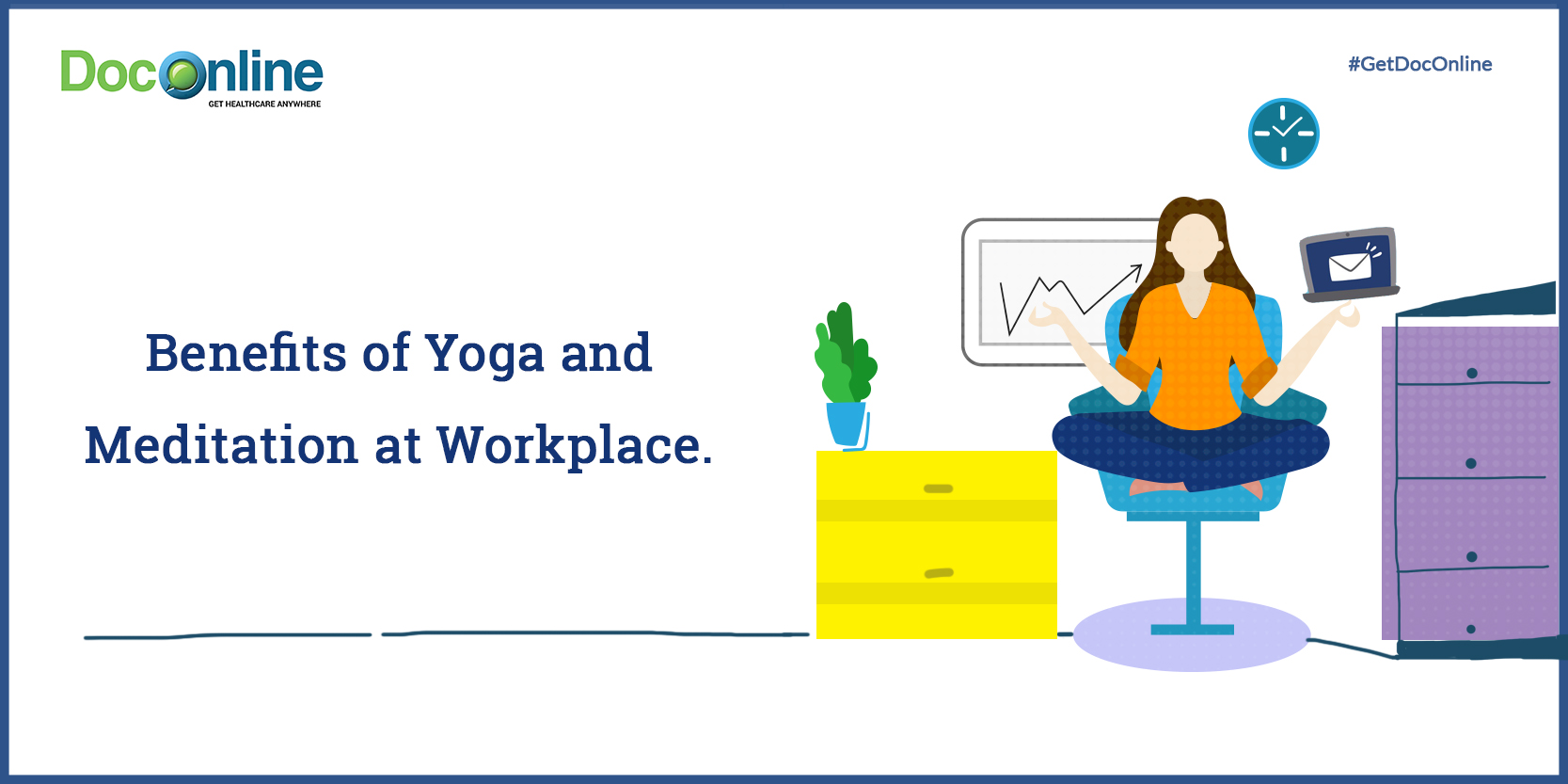The workplace, these days, has become more stressful than ever. The fierce competitive environment coupled with the pressure to meet deadlines keeps people busy on their toes. Moreover, given the modern technology, people are working round the clock even as they carry work to home or while on travel. This build up of stress at workplace has a direct impact on the productivity of individuals and consequently affects the ROI of the organization.
Moreover, these days, employees rarely get time away from work. They work longer hours and hard. The added work pressure together with faulty lifestyles contribute to them becoming anxiety prone, which largely affects their decision-making process, both at home and at work.
Thus, cultivating a positive workplace environment is essential; and this can be successfully achieved by introducing yoga at work without having to make big routine alterations.
So, let us understand why yoga and meditation should be introduced at workplace and how they lead to mindfulness at work, thus improving performance.
Yoga and Meditation are different practices in their own ways, but both are grounded in spirituality and benefit the mind and body.
Yoga combines the physical postures or asanas with conscious breathing. Meditation, on the other hand, helps to keep the mind sharp and clear, relieves one of stress and improves one’s overall sense of well-being.
The most common practice in the workplace is Mindfulness Meditation. It is a practice that brings the mind’s focus to the body and the breathing in order to help improve concentration and promote open awareness of thoughts and feelings.
Apart from reduced stress and improved productivity, regular meditation practice helps to open creative doorways in the brain. With increased focus, problem-solving skills get more creative and new ideas enter the mind more freely. The research on mindfulness suggests that meditation sharpens skills like attention, memory, and emotional intelligence.
Benefits of Yoga and Meditation
It's great to do a yoga routine before or after work, but you could also incorporate some stretches into the rest of your day. Stretch breaks are especially important for people whose jobs require them to sit at a desk in front of a computer for long hours. It can result in back pain and neck pain. Just taking a few minutes to do stretches at your desk can relieve stress, increase productivity, and most importantly, make you feel better.
1. Yoga and meditation:
Improves cardiovascular health, lowering blood pressure and the heart rate. Meditating one time a day for ten minutes can help you relax, reduce stress hormones, lower your blood pressure, and allow for better blood flow.
2.Stress Buster:
Stress effects our minds and bodies in many more ways than we can even imagine. A few minutes of daily yoga can help you release stress and be much more productive than you already are.
3.Treats Back Pain:
Doing few yoga poses throughout the week can help with chronic back pain. Studies have shown that stretching exercises and poses improve spinal flexibility and help ease lower back pain problems in people within one week of yoga.
4.Helps with Asthma:
If you suffer from asthma, then you might want to take up yoga. Pranayama is a type of yoga that focuses on breathing techniques that have shown to be especially effective against asthma.
5.Improves Digestion:
There are many yoga poses that help food move along in your digestive system. Yoga also stimulates the lymphatic system that help flush out toxins, making your body cleaner. Meditation can also help address symptoms of Irritable Bowel Syndrome (IBS) and Irritable Bowel Disease (IBD) by reducing the frequency of stress-related flare-ups.
6.Sleep Better
In order to live a healthy, balanced lifestyle you need to get enough rest so you can function the next day. Meditation and breathing techniques also help clear your mind so you can relax and slow down your thoughts, allowing you to enjoy a peaceful good night’s sleep.
7.Mood Booster:
Yoga and meditation have been linked with emotional health boosts. Studies have shown that yoga and meditation help improve cognitive-behavioral performance as well as aid with mood swings, depression, and anxiety. Practicing yoga in a group setting also stimulates the production of oxytocin, which is the love hormone, and it also produces higher serotonin levels, which is the happy hormone.
8. Migraines:
One of the recommended moves that alleviate migraines is the “bridge pose.” You lie on your back with your knees bent with your feet apart at hip-width on the floor. With your hands on the floor, press down into your legs and draw your hips up. The trick is to relax the tension in your muscles from your neck and shoulders, which can be misaligned or stressed from hunching over a computer or phone all day long.
9.Mental Clarity:
A healthy dose of yoga and meditation will keep your brain sharp and clear. Simple yoga practices and breathing techniques allow you to free your mind from the “clutter” that trickles down to your physical well-being. Slow breathing and yoga poses will help your memory and keep your thoughts more organized, once you get rid of stress, anxiety, and negative thinking.
10. Increases Focus:
By being present “in the moment” you will learn to control your mind. This will help you to focus on the task at hand. A vitally useful skill to have in a fast-paced workplace where multitasking is a way of life.
11.Boosts Immunity:
Yoga activates your immune system, gets your blood flowing and stimulates your lymphatic system. Yoga also supports healthy bones through weight-bearing exercises. That’s a lot of health benefits that lead to less sick days and higher performance amongst employees.
12.Improves Posture:
Sitting all day wreaks havoc on your posture and the natural curves of the spine slowly start to reverse as you hunch over your computer. A huge benefit of yoga is finding the natural curves of the spine by lying on the sides of the waist, tilting the pelvis and broadening the back body. Yoga also stretches major muscles groups and increases joint mobility to prevent joint aches and stiffness.
13.Increases Energy:
Exercise has proven to increase your energy. The less active you are, the quicker you fatigue tire out and the lesser energy you will have to tackle everything. Taking time to focus on yourself, even if it is for a short period is just the boost you need to tackle the rest of your day with vigour.
Lastly, regular practice of yoga and meditation result in happier and focused employees. Professionals have experienced much better connect with their associates after becoming a regular yoga practitioner. These personal bonds due to better clarity, proper understanding and effective communication lead to improved productivity at work.
After all, a happy and productive employee is your best employee!
Looking for Doctor's Advice?













